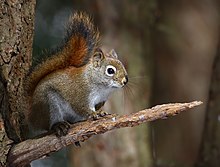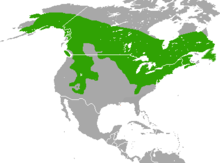Eastern red squirrel
| American red squirrel | |
|---|---|
 |
|
| An American red squirrel at Cap Tourmente National Wildlife Area, Quebec | |
| Scientific classification | |
| Kingdom: | Animalia |
| Phylum: | Chordata |
| Class: | Mammalia |
| Order: | Rodentia |
| Family: | Sciuridae |
| Genus: | Tamiasciurus |
| Species: | T. hudsonicus |
| Binomial name | |
|
Tamiasciurus hudsonicus (Erxleben, 1777) |
|
| Subspecies | |
|
|
 |
|
| Distribution | |
The American red squirrel (Tamiasciurus hudsonicus) is one of three species of tree squirrel currently classified in the genus Tamiasciurus, known as the pine squirrels (the others are the Douglas squirrel, T. douglasii, and Mearns's squirrel, T. mearnsi). American red squirrels are also referred to as pine squirrels, North American red squirrels, boomers, and chickarees. They are medium-sized (200–250 g) diurnal mammals that defend a year-round exclusive territory. The diet of these tree squirrels is specialized on the seeds of conifer cones. As such, they are widely distributed across North America wherever conifers are common, except on the Pacific Coast, where they are replaced by Douglas squirrels. Recently, American red squirrels have been expanding their range to include primarily hardwood areas.
American red squirrels should not be confused with Eurasian red squirrels (Sciurus vulgaris); since the ranges of these species do not overlap, they are both commonly referred to as "red squirrels" in the areas where they are native. The specific epithet hudsonicus refers to Hudson Bay, Canada, where the species was first catalogued by Erxleben in 1771. A recent phylogeny suggests the squirrels as a family can be divided into five major lineages. Red squirrels (Tamiasciurus) fall within the clade that includes flying squirrels and other tree squirrels (e.g., Sciurus). There are 25 recognized subspecies of red squirrels.
Red squirrels can be easily distinguished from other North American tree squirrels by their smaller size, territorial behavior and reddish fur with a white venter (underbelly). Red squirrels are somewhat larger than chipmunks. The Douglas squirrel is morphologically similar to the American red squirrels, but has a rust-colored venter and is restricted to the southwestern coast of British Columbia and in the Pacific Northwest of the United States. These species' ranges do not overlap.
...
Wikipedia

